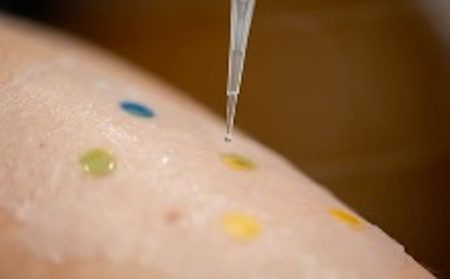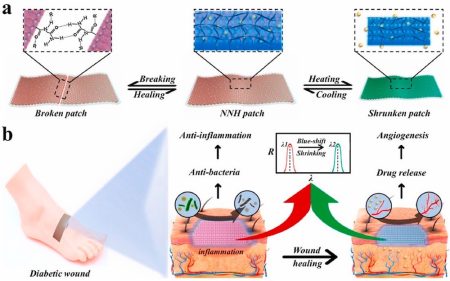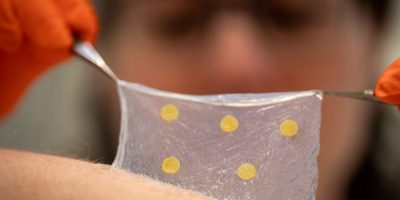Editor’s Blog – Feeling a little off-colour?
Two research projects inject a splash of colour as well as a ray of hope into medical treatment, reports Caroline Hayes.
The first project is from Sweden’s Linköping University, where researchers have developed a nanocellulose wound dressing which changes colour if the wound is infected. The dressing means that the wound can heal without medical staff having to change the dressing every one to two days to keep check for infection. Left undisturbed, scabs can form as part of the healing process, without being broken by the dressing being replaced.
Bacteria in a wound can change the skin’s pH level and by detecting, and signalling, any increase in pH levels, the dressing is an earlier signal than any redness, soreness or pus around the area which are visual cues used when changing dressings.

Infection indicated by a rise in the skin’s pH causes the dressing to change colour. (Picture: Linköping University, Sweden)
The researchers integrated bromthymol blue (BTB) dye into a silica mesh material. The dye changes colour from yellow to blue when the pH value exceeds 7. Non-infected wounds have a pH of 5.5, and a pH of 8 or higher indicates an infection. The mesh material is then combined with the dressing and applied to wounds.
The dressing presents a window to the wound beneath and also reduces the need for antibiotics because an infection can be treated locally and in the early stages.
The mesh nanocellulose prevents bacteria and other microbes from entering the wound. The research team, led by Daniel Aili, professeor in Biophysics and Bioengineering at Linköping University, is collaborating with colleagues from Örebro University to develop anti-microbial substances based on lipopeptides to kill bacteria, further reducing the risk of infection.
Hydrogel diabetes patch
Addressing diabetes sufferers, work at the Nanjing University Medical School and Medical University, Wenzhou in China, focuses on a hydrogel patch with anti-bacterial but also anti-inflammatory drug delivery systems.
The chronic disease, diabetes mellitus brings about a non-healing chronic wound. The condition is defined by a prolonged inflammatory period, reduced neovascularisation and impaired endothelial cell function which hampers healing.
The researchers created supramolecular hydrogels, derived from the assembly of supramolecular polymer networks, for a stronger structure, combined with coloured polymers which react as conditions change. While supramolecular hydrogels have been used for some time in biomedical applications, where their mechanical strength, self-healing, antibacterial and anti-inflammatory properties are valued, they have not been combined with structural colour polymers in nanostructures where colour is visible through light interaction. These are conventionally used in optical displays, anti-counterfeiting labels and wearable electronics. The responsive coloured polymers which swell or shrink with different simulations to indicate sensor values of the material.
The hydrogel patches can be formed into shapes and also retain moisture, making them suitable to administer treatment to wounds in ‘awkward’ places.

Figure 2: The hydrogel patches can administer treatment directly to a diabetic wound. (Picture credit: Chen, Wang, Zhang, Zhang, Dong, Sun, Zhao)
Typical hydrogel patches are simplistic in composition or structure, limiting the capacity as responsive anti-bacterial and anti-inflammatory patches. The simple structure also means they can lack mechanical strength making them brittle. Few, typically, have real-time monitoring properties which allow physicians to evaluate the wound beneath.
The supramolecular hydrogel patch was created by using N-acryloyl glycinamide (NAGA) and 1-vinyl-1,2,4-triazole (VTZ) mixed supramolecular hydrogel as the inverse opal scaffold, and temperature responsive poly(N-isopropylacrylamide) (PNIPAM) hydrogel loaded with vascular endothelial cell growth factor (VEGF) as a filler. PNIPAM releases actives in response to thermal stimuli to apply treatment directly to an area. The supramolecular hydrogel provides mechanical properties, the NAGA provides self-healing properties and the VTZ delivers anti-bacterial properties to the patch.
The patch was tested on diabetic rats where it was shown to “significantly enhance” the wound healing process by downregulating the expression of inflammatory factors promoting collagen deposition and angiogenesis.
The structure also allows the patch also use colour to indicate variations in temperature to release treatment. The colour changes are also a guide for clinical treatment and wound monitoring or management.




